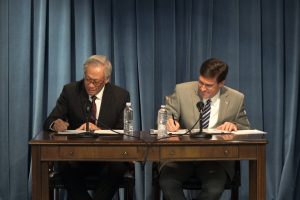Over the weekend, Singapore and the United States signed an agreement that facilitates the addition of a Singapore fighter training detachment in Guam. While the move builds on existing U.S.-Singapore defense collaboration in this regard, it nonetheless constituted another boost for the relationship between the two countries.
As I have noted before in these pages, Singapore and the United States have long had a defense relationship as part of what is officially termed as a strategic partnership. The United States is a key supplier of defense technology and facilities for military training for Singapore, while the city-state is a valuable regional partner across a range of issues from counterterrorism to maritime security.
Over the weekend, the defense aspect of the relationship was in the spotlight again with the inking of a new security agreement. The agreement, signed between Singapore’s visiting Defense Minister Ng Eng Hen and U.S. Defense Secretary Mark Esper on the sidelines of the 7th Reagan National Defense Forum establishes a new fighter aircraft training detachment in Guam.
Per details released by Singapore’s defense ministry, the agreement lays out the framework for the establishment of a Republic of Singapore Air Force (RSAF) fighter training detachment at Andersen Air Force Base (AAFB), Guam, covering the deployment of RSAF F-15SG, F-16 fighter aircraft, and other supporting assets such as the Gulfstream 550 – Airborne Early Warning (G550-AEW) to AAFB for training.
The agreement has both operational as well as wider strategic significance. Operationally, while it builds on existing training Singapore has done in Guam since the 1990s and periodic deployments there since 2017, it effectively and officially adds a fourth RSAF detachment on U.S. territory following ones in Arizona and Idaho. These detachments, along with other deployments Singapore has in regional countries such as Australia, India, and Thailand, afford the RSAF more space to train and also serve as avenues to deepen bilateral collaboration.
From a more strategic perspective, it constitutes the latest in a series of recent developments that have reinforced the continuing progress being made in U.S.-Singapore defense relations. As I have observed before, we have seen a number of boosts in the last few years on the defense side, be it the addition of exercises such as Pacific Griffin or the renewal of a key military facilities agreement earlier this year. This has come even amid some lingering concerns about an uptick in China-Singapore cooperation, including on the security side.
To be sure, these inroads ought not to detract from the fact that there continue to remain uncertainties and challenges for the wider U.S.-Singapore relationship, be it evolving domestic political dynamics in both countries or regional trends such as China’s continued assertiveness. Indeed, Ng alluded to some of the concerns on U.S. policy in his remarks at the 7th Reagan National Defense Forum, though this was framed more as what regional countries expected from the United States on aspects such as China policy, free trade, and multilateralism.
With the agreement now signed, the focus will now shift to the ways in which both sides will look to implement it in the coming months, and what other periodic inroads we may see in that respect. How that all unfolds will provide insights into this aspect of the U.S.-Singapore defense relationship amid wider domestic and regional dynamics.
































